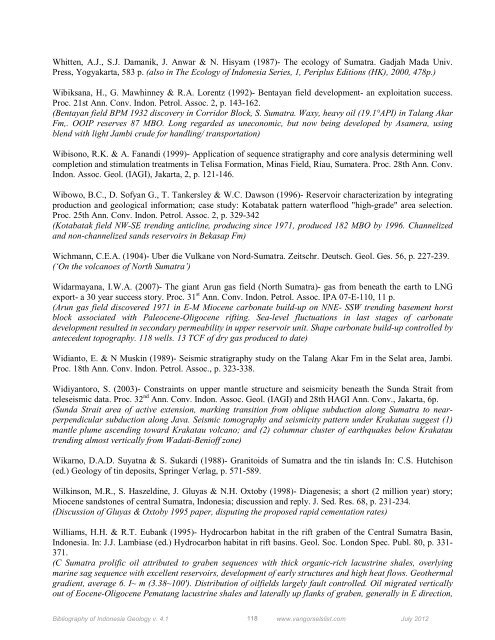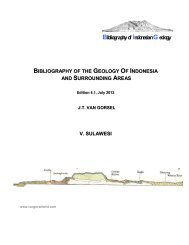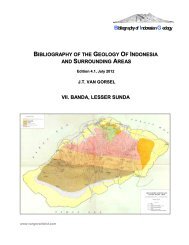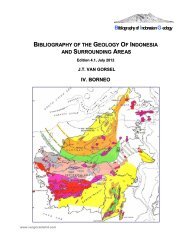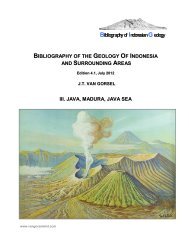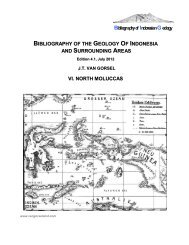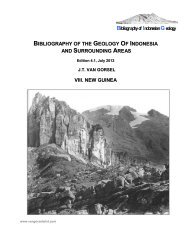Sumatra, Sunda Shelf, Natuna - Bibliography of Indonesia Geology
Sumatra, Sunda Shelf, Natuna - Bibliography of Indonesia Geology
Sumatra, Sunda Shelf, Natuna - Bibliography of Indonesia Geology
Create successful ePaper yourself
Turn your PDF publications into a flip-book with our unique Google optimized e-Paper software.
Whitten, A.J., S.J. Damanik, J. Anwar & N. Hisyam (1987)- The ecology <strong>of</strong> <strong>Sumatra</strong>. Gadjah Mada Univ.<br />
Press, Yogyakarta, 583 p. (also in The Ecology <strong>of</strong> <strong>Indonesia</strong> Series, 1, Periplus Editions (HK), 2000, 478p.)<br />
Wibiksana, H., G. Mawhinney & R.A. Lorentz (1992)- Bentayan field development- an exploitation success.<br />
Proc. 21st Ann. Conv. Indon. Petrol. Assoc. 2, p. 143-162.<br />
(Bentayan field BPM 1932 discovery in Corridor Block, S. <strong>Sumatra</strong>. Waxy, heavy oil (19.1°API) in Talang Akar<br />
Fm,. OOIP reserves 87 MBO. Long regarded as uneconomic, but now being developed by Asamera, using<br />
blend with light Jambi crude for handling/ transportation)<br />
Wibisono, R.K. & A. Fanandi (1999)- Application <strong>of</strong> sequence stratigraphy and core analysis determining well<br />
completion and stimulation treatments in Telisa Formation, Minas Field, Riau, Sumatera. Proc. 28th Ann. Conv.<br />
Indon. Assoc. Geol. (IAGI), Jakarta, 2, p. 121-146.<br />
Wibowo, B.C., D. S<strong>of</strong>yan G., T. Tankersley & W.C. Dawson (1996)- Reservoir characterization by integrating<br />
production and geological information; case study: Kotabatak pattern waterflood "high-grade" area selection.<br />
Proc. 25th Ann. Conv. Indon. Petrol. Assoc. 2, p. 329-342<br />
(Kotabatak field NW-SE trending anticline, producing since 1971, produced 182 MBO by 1996. Channelized<br />
and non-channelized sands reservoirs in Bekasap Fm)<br />
Wichmann, C.E.A. (1904)- Uber die Vulkane von Nord-<strong>Sumatra</strong>. Zeitschr. Deutsch. Geol. Ges. 56, p. 227-239.<br />
(‘On the volcanoes <strong>of</strong> North <strong>Sumatra</strong>’)<br />
Widarmayana, I.W.A. (2007)- The giant Arun gas field (North <strong>Sumatra</strong>)- gas from beneath the earth to LNG<br />
export- a 30 year success story. Proc. 31 st Ann. Conv. Indon. Petrol. Assoc. IPA 07-E-110, 11 p.<br />
(Arun gas field discovered 1971 in E-M Miocene carbonate build-up on NNE- SSW trending basement horst<br />
block associated with Paleocene-Oligocene rifting. Sea-level fluctuations in last stages <strong>of</strong> carbonate<br />
development resulted in secondary permeability in upper reservoir unit. Shape carbonate build-up controlled by<br />
antecedent topography. 118 wells. 13 TCF <strong>of</strong> dry gas produced to date)<br />
Widianto, E. & N Muskin (1989)- Seismic stratigraphy study on the Talang Akar Fm in the Selat area, Jambi.<br />
Proc. 18th Ann. Conv. Indon. Petrol. Assoc., p. 323-338.<br />
Widiyantoro, S. (2003)- Constraints on upper mantle structure and seismicity beneath the <strong>Sunda</strong> Strait from<br />
teleseismic data. Proc. 32 nd Ann. Conv. Indon. Assoc. Geol. (IAGI) and 28th HAGI Ann. Conv., Jakarta, 6p.<br />
(<strong>Sunda</strong> Strait area <strong>of</strong> active extension, marking transition from oblique subduction along <strong>Sumatra</strong> to near-<br />
perpendicular subduction along Java. Seismic tomography and seismicity pattern under Krakatau suggest (1)<br />
mantle plume ascending toward Krakatau volcano; and (2) columnar cluster <strong>of</strong> earthquakes below Krakatau<br />
trending almost vertically from Wadati-Beni<strong>of</strong>f zone)<br />
Wikarno, D.A.D. Suyatna & S. Sukardi (1988)- Granitoids <strong>of</strong> <strong>Sumatra</strong> and the tin islands In: C.S. Hutchison<br />
(ed.) <strong>Geology</strong> <strong>of</strong> tin deposits, Springer Verlag, p. 571-589.<br />
Wilkinson, M.R., S. Haszeldine, J. Gluyas & N.H. Oxtoby (1998)- Diagenesis; a short (2 million year) story;<br />
Miocene sandstones <strong>of</strong> central <strong>Sumatra</strong>, <strong>Indonesia</strong>; discussion and reply. J. Sed. Res. 68, p. 231-234.<br />
(Discussion <strong>of</strong> Gluyas & Oxtoby 1995 paper, disputing the proposed rapid cementation rates)<br />
Williams, H.H. & R.T. Eubank (1995)- Hydrocarbon habitat in the rift graben <strong>of</strong> the Central <strong>Sumatra</strong> Basin,<br />
<strong>Indonesia</strong>. In: J.J. Lambiase (ed.) Hydrocarbon habitat in rift basins. Geol. Soc. London Spec. Publ. 80, p. 331-<br />
371.<br />
(C <strong>Sumatra</strong> prolific oil attributed to graben sequences with thick organic-rich lacustrine shales, overlying<br />
marine sag sequence with excellent reservoirs, development <strong>of</strong> early structures and high heat flows. Geothermal<br />
gradient, average 6. I~ m (3.38~100'). Distribution <strong>of</strong> oilfields largely fault controlled. Oil migrated vertically<br />
out <strong>of</strong> Eocene-Oligocene Pematang lacustrine shales and laterally up flanks <strong>of</strong> graben, generally in E direction,<br />
<strong>Bibliography</strong> <strong>of</strong> <strong>Indonesia</strong> <strong>Geology</strong> v. 4.1 118 www.vangorselslist.com July 2012


